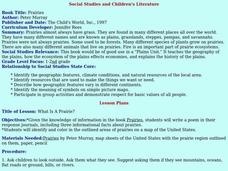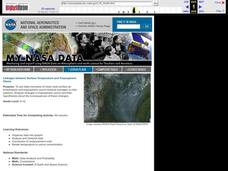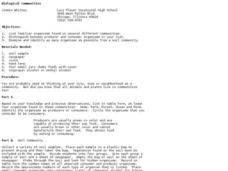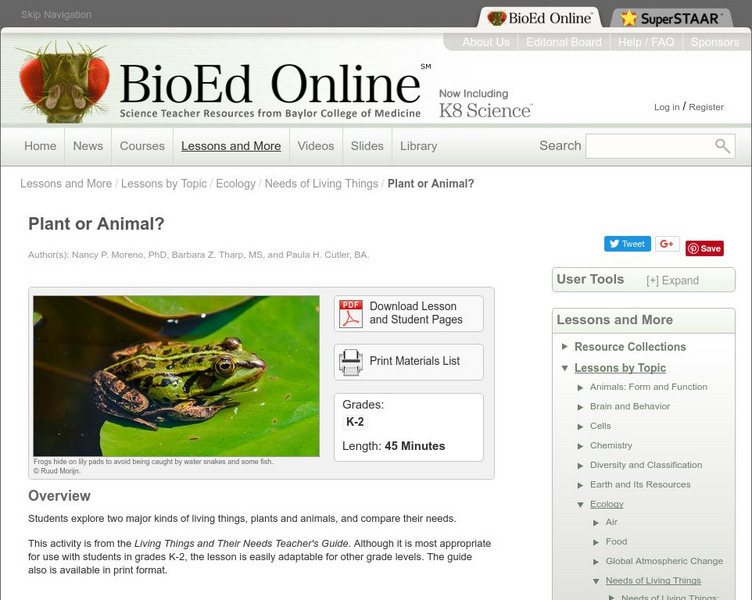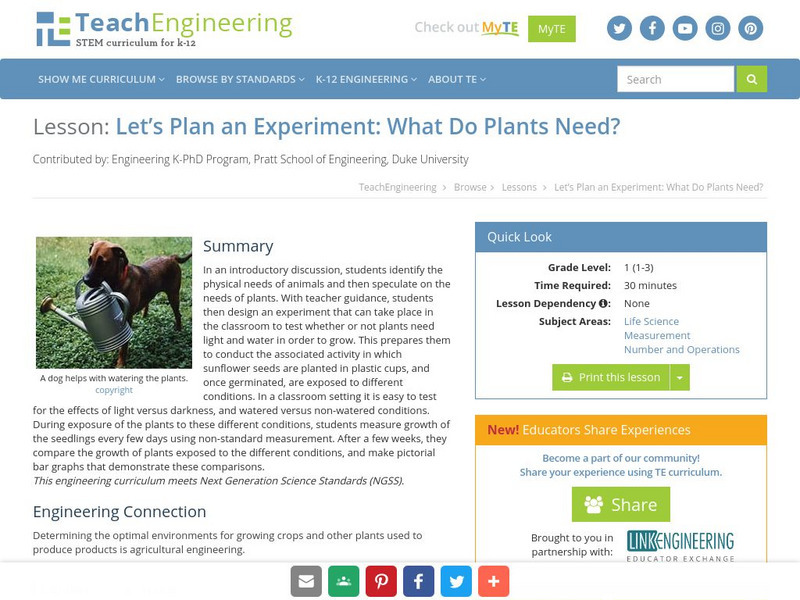Curated OER
Food Webs
Fourth graders discover how organisms depend upon each other in an ecosystem. In this ecosystems instructional activity, 4th graders use food webs to discuss the interdependence between organisms in an ecosystem.
Curated OER
Social Studies and Children's Literature
Pupils write a journal in response to literature. The story that is read is about prairies. The subject of prairies becomes an object for research. The culminating activity is the making of a map where prairies exist in the United States.
Curated OER
Ecological Communities:The Prairie
Students study the meaning of ecological community and recognize its complexity. For this ecology lesson students diagram a food web.
Curated OER
Land Use
Learners examine ecosystems that covered Illinois 200 years ago, investigate some living and non-living components of ecosystems, identify components of prairie system, create food webs, and observe human effects on environment. Lessons...
Curated OER
Mississippi Gulf Coast Islands
Fourth graders complete a variety of exercises as they study the creation, history, and geography of the Mississippi coastal islands. They discover the natuaral forces that act on the islands and how these forces affect the habitats and...
Curated OER
Linkages Between Surface Temperature And Tropospheric Ozone
Students organize and analyze data regarding changes in tropospheric ozone and then hypothesize about the consequences of these changes.
Curated OER
Advances in Civilization: A Car or a Horse?
Fourth graders investigate the ways in which horses made transportation, hunting and agriculture much easier for the native peoples. They then compare advantages of a horse "back then" to the ease transportation (mainly cars) make on our...
Curated OER
Learning About Bears
Students receive instruction about the different types of bears: Brown bears, Polar bears, and Panda bears. They then work on a worksheet independently to show how well they comprehended the instruction.
Curated OER
Karl Bodmer Art Cube
Middle schoolers use the internet to research the type of art done by Karl Bodmer. Using this information, they design and create their own art cube relating to the artist's life. They also write a paragraph about what they believe their...
Curated OER
What Killed the Dinosaurs?
High schoolers demonstrate how scientists use evidence to formulate hypotheses. They write an essay describing the Cretaceous and Paleocene time periods from the point of view of someone living in that time. In addition, they formulate...
Curated OER
Our Schoolsyard is Full of Biology
Students study the habitats found in their schoolyard. They apply firsthand, what they have learned in the classroom to something familiar to them. Students look at biotic, abiotic habitats. Small groups will present their findings to...
Curated OER
Windsor Opposes Waste - WOW!
Students participate in paper recycling. They are taught to environmental awareness of recycling and its importance in their future. Students discuss and identify the problems of how they can minimize waste. They brainstorm suggestions...
Curated OER
Biological Communities
Students identify consumers and producers in different communities. Students collect a variety of soil samples and record organisms found in the samples.
Curated OER
Building a Mini-park And Bird Sanctuary Lesson 3: Location, Location, Location
Pupils work cooperatively using the democratic process to select a place for a park. They identify how the garden in the park will look. They write a five paragraph essay as an assessment.
Curated OER
Insect Biology and Ecology: A Primer
Students explore insects and closely related organisms. They examine the growth and development of a lady beetle. Students classify insects and organize them. They investigate pest management.
Curated OER
Life Cycle of a Frog
Learners observe the life cycle of a frog. In this life cycle instructional activity, students will observe and record the changes in the life cycle of a frog.
Curated OER
Make an Edible Coral Reef
Students create an edible coral reef out of food and candy. In this Science lesson, students explore what a coral reef is and the coral reef's importance to the ecosystem. Additionally, students discover the different parts of a...
BioEd Online
Bio Ed Online: Living Things and Their Needs: Plant or Animal?
In this lesson, students investigate and compare the needs of plants and animals. The lesson can be downloaded in PDF format.
University of California
South Coast Science Project: Mimicking Plants and Animals Lesson Plan
In this lesson, students are challenged to think about external features that animals and plants have that humans have copied. Students then apply their engineering skills to design a jacket. In addition, this activity introduces the...
PBS
Pbs Learning Media: Animals and Plants Can Live in a City!
In this interactive lesson, students learn that animals need air, food, water, and shelter, while plants need air, sunlight, and water. Students watch videos and engage with drawing and sorting activities to reinforce their learning....
BioEd Online
Bio Ed Online: Living Things and Their Needs: We Need Water
This lesson focuses on living things' need for water. Students make lemonade and learn that water can be found in liquids other than a glass of water, and is also found in plants. The lesson can be downloaded in PDF format.
TeachEngineering
Teach Engineering: Who Needs What?
The teacher leads a discussion in which students identify the physical needs of animals, and then speculate on the needs of plants. With guidance from the teacher, the students then help design an experiment that can take place in the...
PBS
Pbs Learning Media: The Needs of Living Things
In this lesson, learners watch video clips of animals and plants in their natural environment, to gather evidence that all living things have basic needs that must be met in order to survive. Then, to illustrate their understanding of...
Science Education Resource Center at Carleton College
Serc: Mn Step: Who Am I? Plant and Animal Life in a Pond
After learning about pond life, students play a game where they must ask questions to discover the name of an animal or a plant displayed on a card placed on their backs. A set of images, a questioning sheet, and a list of vocabulary...

